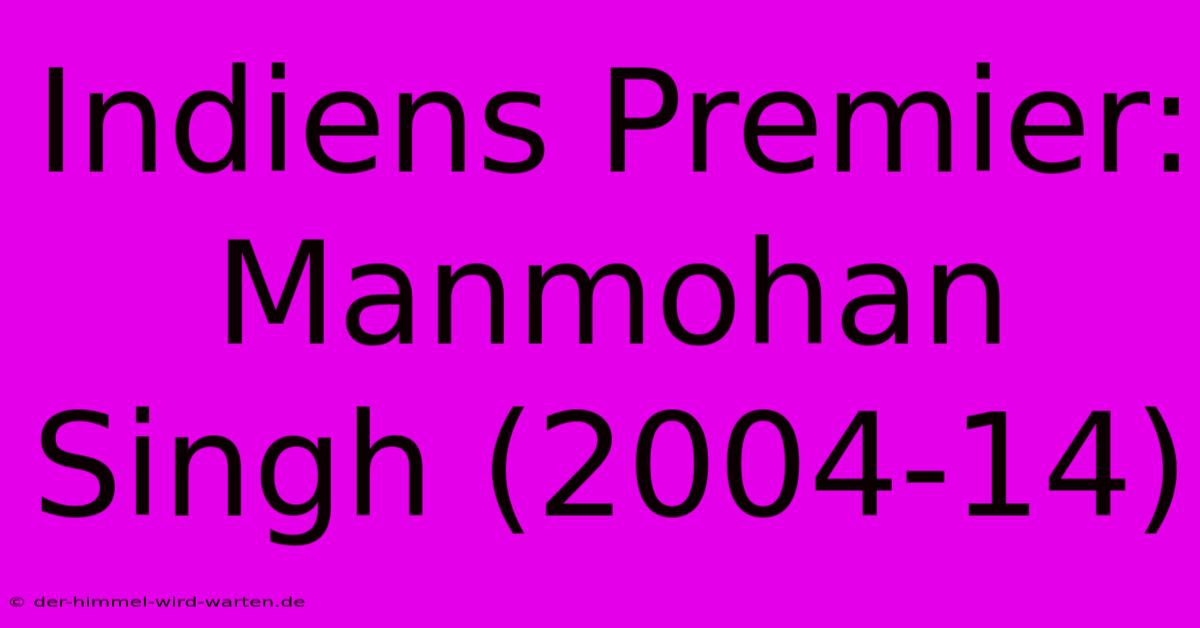Indiens Premier: Manmohan Singh (2004-14)

Discover more detailed and exciting information on our website. Click the link below to start your adventure: Visit My Website. Don't miss out!
Table of Contents
India's Premier: Manmohan Singh (2004-14) – A Decade of Reform and Challenges
Hey everyone, so I wanted to talk about Manmohan Singh's time as Prime Minister of India, from 2004 to 2014. It's a fascinating period, and honestly, one I didn't fully grasp until I started digging into it for this post. I mean, I knew the basics – economic reforms, the 26/11 attacks – but there's so much more to it. It's like peeling back layers of an onion, you know? Each layer reveals something new, sometimes surprising.
The Legacy of Economic Liberalization
Singh, a renowned economist, came into office with a strong focus on continuing India's economic liberalization. This wasn't just some buzzword, either; it involved real policy changes. Think about the National Rural Employment Guarantee Act (NREGA), for example. This massive program aimed to guarantee employment for rural workers, a huge step towards addressing poverty and inequality. I remember reading articles at the time; it was controversial, some people thought it would be too expensive, others praised its potential to reduce rural distress.
It's complicated, right? Because it was never just about the economics. It's also important to remember the social and political context. NREGA, for example, faced challenges in implementation and faced criticism for being inefficient in certain areas. But it was a bold attempt to tackle a massive social problem. That's what makes studying this era so interesting.
Navigating Global Economic Shocks
Remember the 2008 global financial crisis? Yeah, India wasn't immune. Singh's government had to navigate that turbulent period, implementing stimulus packages to keep the economy afloat. It wasn't easy; there was a lot of debate about the best approach. And, to be honest, I struggled to understand some of the economic arguments back then. It’s all so much jargon sometimes!
But looking back, you can see the government's attempts to cushion the impact. They weren't perfect, and there were criticisms about transparency and efficiency. But, again, it's about understanding the context. It wasn't just about spreadsheets and numbers, but about real people and their livelihoods.
The 26/11 Attacks and National Security
The 2008 Mumbai terror attacks were a defining moment. The scale of the attacks, the sheer brutality, it shook the nation. The government's response, both in terms of immediate security measures and long-term counter-terrorism strategies, is still debated. There were criticisms about intelligence failures and the government's effectiveness in dealing with the aftermath.
This period highlighted the complex relationship between national security and domestic policy. There were increased security measures, of course. But there was also a lot of public discussion about the root causes of terrorism, and the need for a comprehensive approach that addressed social and political factors, too. This wasn't just about bombs and guns; it was also about ideas and ideologies.
A Coalition Government's Challenges
Singh led a coalition government, which inherently presented its own set of challenges. Balancing the interests of various parties, managing internal disagreements, it was a constant juggling act. There were times, I remember reading, where policy decisions were delayed or compromised due to coalition politics.
This is one area where I'm still learning. Understanding the dynamics of coalition governments, the internal power struggles, the compromises, it's complex stuff. But it's crucial to understanding the political context of this era.
Conclusion: A Mixed Legacy
Manmohan Singh's tenure as Prime Minister was a complex and multifaceted period. It wasn't all sunshine and roses. He faced major economic challenges, internal political conflicts, and national security threats. His government achieved significant economic progress in certain areas, but also faced criticism for its handling of some crises. Ultimately, his legacy is a subject of ongoing debate, which honestly, makes researching and writing about it all the more interesting. It's a story that deserves a deeper look, and I hope this post has given you a little nudge to do just that. Let me know your thoughts in the comments!

Thank you for visiting our website wich cover about Indiens Premier: Manmohan Singh (2004-14). We hope the information provided has been useful to you. Feel free to contact us if you have any questions or need further assistance. See you next time and dont miss to bookmark.
Also read the following articles
| Article Title | Date |
|---|---|
| Fulham Beendet Chelsea Siegesserie In Stamford Bridge | Dec 27, 2024 |
| Alpin Sturz Sarrazin Verletzt Sich | Dec 27, 2024 |
| Schwierige Bestaetigungssaison Fuer Sarrazin | Dec 27, 2024 |
| 2004 Tsunami Eine Welt In Trauer | Dec 27, 2024 |
| Tsunami 2004 Gedenken An Die Katastrophe | Dec 27, 2024 |
